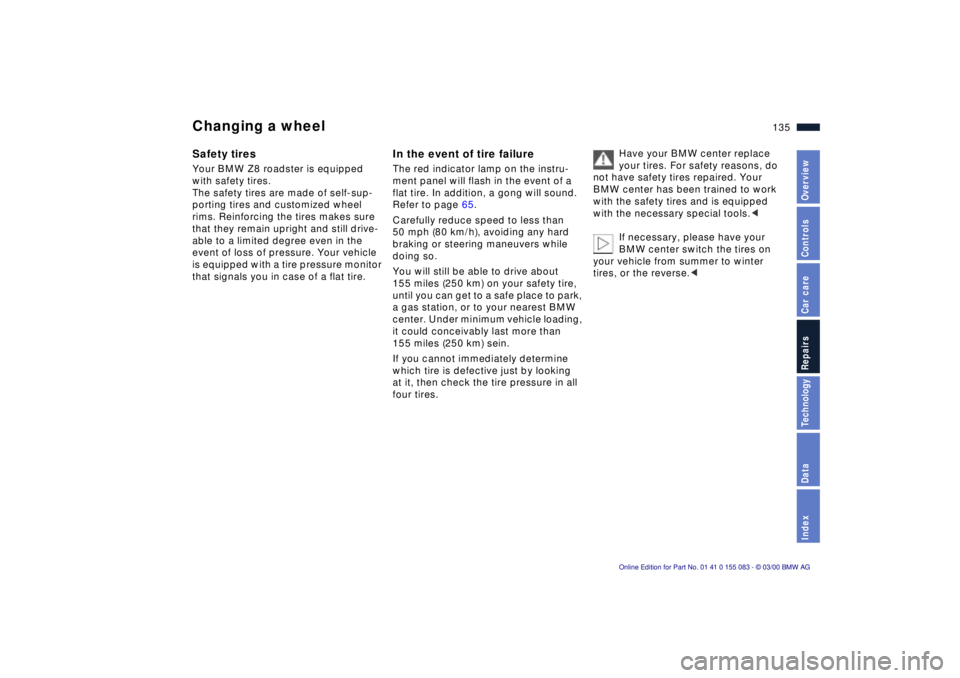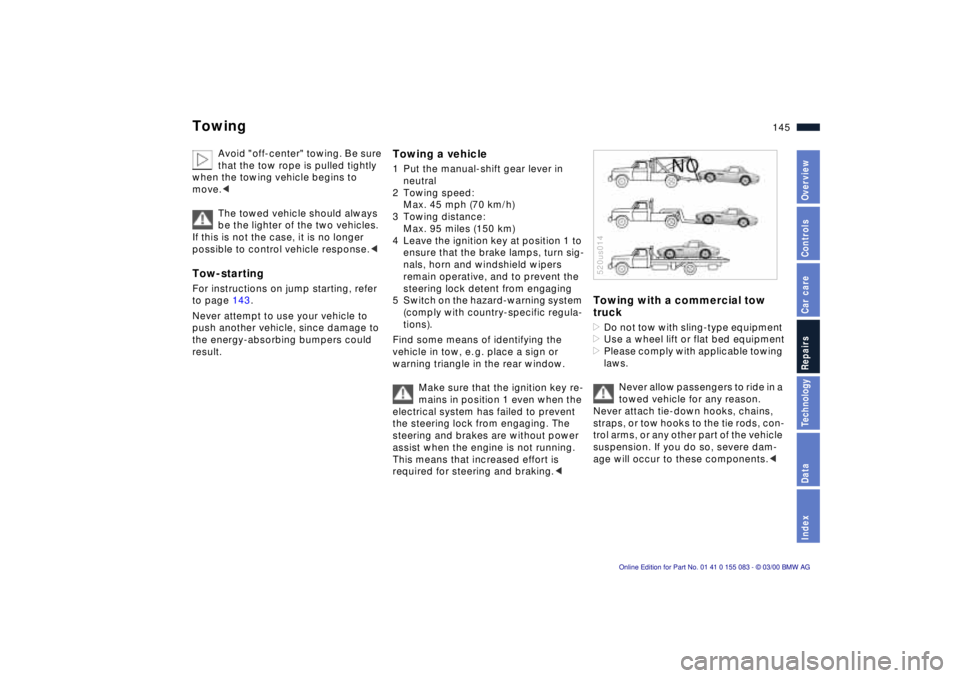2000 BMW Z8 steering wheel
[x] Cancel search: steering wheelPage 136 of 172

135n
IndexDataTechnologyRepairsCar careControlsOverview
Changing a wheel Safety tiresYour BMW Z8 roadster is equipped
with safety tires.
The safety tires are made of self-sup-
porting tires and customized wheel
rims. Reinforcing the tires makes sure
that they remain upright and still drive-
able to a limited degree even in the
event of loss of pressure. Your vehicle
is equipped with a tire pressure monitor
that signals you in case of a flat tire.
In the event of tire failure The red indicator lamp on the instru-
ment panel will flash in the event of a
flat tire. In addition, a gong will sound.
Refer to page 65.
Carefully reduce speed to less than
50 mph (80 km/h), avoiding any hard
braking or steering maneuvers while
doing so.
You will still be able to drive about
155 miles (250 km) on your safety tire,
until you can get to a safe place to park,
a gas station, or to your nearest BMW
center. Under minimum vehicle loading,
it could conceivably last more than
155 miles (250 km) sein.
If you cannot immediately determine
which tire is defective just by looking
at it, then check the tire pressure in all
four tires.Have your BMW center replace
your tires. For safety reasons, do
not have safety tires repaired. Your
BMW center has been trained to work
with the safety tires and is equipped
with the necessary special tools.<
If necessary, please have your
BMW center switch the tires on
your vehicle from summer to winter
tires, or the reverse.<
Page 146 of 172

145n
IndexDataTechnologyRepairsCar careControlsOverview
Towing
Avoid "off-center" towing. Be sure
that the tow rope is pulled tightly
when the towing vehicle begins to
move.<
The towed vehicle should always
be the lighter of the two vehicles.
If this is not the case, it is no longer
possible to control vehicle response.<
Tow-startingFor instructions on jump starting, refer
to page 143.
Never attempt to use your vehicle to
push another vehicle, since damage to
the energy-absorbing bumpers could
result.
Towing a vehicle1 Put the manual-shift gear lever in
neutral
2 Towing speed:
Max. 45 mph (70 km/h)
3 Towing distance:
Max. 95 miles (150 km)
4 Leave the ignition key at position 1 to
ensure that the brake lamps, turn sig-
nals, horn and windshield wipers
remain operative, and to prevent the
steering lock detent from engaging
5 Switch on the hazard-warning system
(comply with country-specific regula-
tions).
Find some means of identifying the
vehicle in tow, e. g. place a sign or
warning triangle in the rear window.
Make sure that the ignition key re-
mains in position 1 even when the
electrical system has failed to prevent
the steering lock from engaging. The
steering and brakes are without power
assist when the engine is not running.
This means that increased effort is
required for steering and braking.<
Towing with a commercial tow
truck>Do not tow with sling-type equipment
>Use a wheel lift or flat bed equipment
>Please comply with applicable towing
laws.
Never allow passengers to ride in a
towed vehicle for any reason.
Never attach tie-down hooks, chains,
straps, or tow hooks to the tie rods, con-
trol arms, or any other part of the vehicle
suspension. If you do so, severe dam-
age will occur to these components.<520us014
Page 150 of 172

149n
IndexDataTechnologyRepairsCar careControlsOverview
Highly sensitive sensors monitor the
number of revolutions of the wheels,
steering angle, lateral acceleration,
brake pressure and the movement
of the vehicle around its vertical axis.
If differences in wheel speed should
occur, the system will recognize the
danger this loss of traction causes and
reduce the drive torque going to the
wheels. The system will also apply the
brakes specifically to the rear wheels,
if necessary.
In addition, DSC permanently monitors
the vehicle's current operating condi-
tion and compares it with an ideal con-
dition that is calculated from the sen-
sor's signals. If differences such as
under- or oversteering should occur,
DSC will stabilize the vehicle in frac-
tions of a second by reducing engine
power output, applying the brakes to
individual rear wheels Ð and to specific
front wheels, too, if necessary. As a
result, dangerous skids can be pre-
vented even as they are beginning.You may need some time to become
accustomed to this system's interven-
tion. However, it provides optimum
drive force and vehicle stability.
The braking intervention may be
accompanied by sounds specific to
the system.
The safety belt tensioner responds to
severe frontal collisions by tightening
the belt to ensure that occupants
remain firmly positioned in their seats.
A gas-pressure system retracts the
buckle assembly to tension the shoul-
der and lap belts within fractions of a
second. This reduces the tendency to
slide under the lap belt.
520de148
DSC Safety belt tensioner
Page 166 of 172

Everything from A to Z
165n
IndexDataTechnologyRepairsCar careControlsOverview
Paintwork, minor
repairs118
Paintwork, waxing118
Parking brake55
Parking lamps68
Parking, winter91
Performance154
Pocket flashlight77
Pollen73
Power steering92
Power windows38
Pressure monitoring,
tires65
Pressure, tires24,96
Pre-warmed seats75 R
Radio62
refer also to the radio
Owner's Manual
Radio reception92,148
Radios92
RDW (Tire Pressure
Warning)65
Reading lamps69
Rear foglamps68
Rear lamp130
Rear window
defroster58,73
Rearview mirror45
Recirculated air mode72 Refueling23
Remaining fuel indicator60
Remote control31
Removing condensation
from the windows73
Removing the vehicle from
storage122
Replacement keys28
Reporting Safety Defects5
Restraint systems51
Reverse15,56
Roof load capacity156
Rotating the tires100
Rubber parts90
S
Safety belt tensioner149
Safety belts48
Safety buttons34
Seat heating75
Securing cargo81
Self-defrosting mirrors45
Service and Warranty
Information Booklet
(US models)114
Service Interval
Display61,114
Shelves76,77
Side airbags49
Side lamps67 Side marker lamps67
bulb
replacement129,130
Sliding91
Slippery roads91
Snow chains90,103
Socket80
Spare key28
Spark plugs158
Speaker79
Speed control59
Speedometer16
Starting54
Starting
problems85,143,144
Steel wheels103
Steering92
Steering wheel lock53
Stopping the vehicle54
Storage areas76,77
Storing your vehicle122
Stroke154
Summer tires101
Switching off the engine54
Symbols2,136
T
Tachometer60
Taillamps
bulb replacement130
Tank capacity157
Technical data154 Technical
modifications4,123
Telephone79
Temperature display
outside temperature62
Temperature gauge
engine coolant61
Temperature layering73
Tilt alarm32
Tilt sensor alarm sensor37
Tire codes101
Tire damage97
Tire inflation
pressure24,96
Tire pressure monitoring65
Tire Pressure Warning
(RDW)65
Tire replacement98,99
Tire rotation100
Tire specifications103
Tire tread97
Together19
Tools128
Torque154
Tow fittings144
Tow starting144
Towing144
Track155
Traction Control System
refer to DSC63
Transmission56
Transmitter key28
Tread depth, tires97
Page 168 of 172

Owner service procedures
167n
IndexDataTechnologyRepairsCar careControlsOverview
A
Add brake fluid112
Add engine coolant112
Adding engine oil109
Adjust washer nozzles108
Avoiding a false alarm37
Avoiding unwanted
alarm37 B
Backup lamps
bulb replacement130
Battery
add distilled water136
charging137
Brakes, brake faults89,90 C
Changing a wheel135
Changing tires135
Checking air pressure24
Checking engine oil
level109
Convertible top
closing in event of electri-
cal malfunction140 D
Defrost position73
Defrosting the windows73 Difficult steering92
Doors
emergency actuation30
E
Electrical defect
convertible top140
Electrical equipment
failure138
Electrical failure
fuel filler door140
Emergency activation
convertible top140
Emergency actuation
doors30
Emergency release
fuel filler door140
Engine oil
add109
quality110
specifications110
viscosity110 F
Fittings, tow starting and
towing144
Flat tire135
Fuel filler door
manual release after
electrical fault140
H
Hazard warning flashers22
Hazard warning triangle22
Headlamp cover, care129
Hood release104 I
Indicator lamps18
Inflation pressure24
Interior lamps
bulb replacement133 L
License plate lamp
bulb replacement131
Luggage compartment lid,
emergency release35 M
Maintenance114 O
Oil
quality110
specifications110
viscosity110
Onboard tool kit128 P
Pressure, tires24
R
Rear foglamp
bulb replacement130
Refill washer reservoir108
Refill windshield washer
resevoir108
Removing condensation
from the windows73
Replacing fuses138
Replacing lamp bulbs129
Replacing windshield wiper
blades128
Replenish washer fluid108
Return used batteries138 S
Starting
problems54,85,144
Switching off the interior
motion sensor37
Switching off the tilt sensor
alarm system37 T
Taillamp130
Tire damage97
Tools128
Tow fittings144
Tow starting144
Towing144
Trunk, emergency
release35
Selbsthilfe